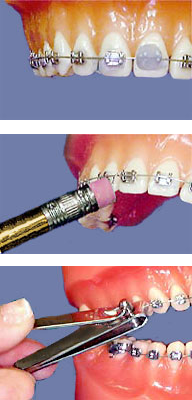At first, getting braces may take a little getting used to. It is common to have a bit of soreness when braces are first applied, or some minor aches as your teeth begin moving into their new positions. But it is good to know that actual orthodontic emergencies are rare.
If you do think that you have an emergency, however, the first step is to determine how severe the problem is: Is it an urgent situation that requires immediate attention from your orthodontist, or is it a minor problem that you can handle yourself, temporarily, until you can come in to the orthodontist’s office?
A Real Major Emergency
There are only several true orthodontic (or dental) emergencies. They are:
- Trauma or injury to the teeth, mouth or face
- Infection or swelling of the gums, face or mouth
- Severe discomfort or pain in the teeth, mouth or face
With any of these situations, you should get help as soon as possible. Go to an emergency room, if that is your best option. Generally, though, the best place to start is at the dental office. For example, if you have a broken tooth, that problem requires immediate treatment. Afterwards, your orthodontic program can be modified as needed. Similarly, severe swelling or pain could indicate an infection or disease, which also needs immediate handling.
More Minor Troubles
Luckily, the vast majority of orthodontic problems are minor compared to the situations described above. But they can still cause discomfort. Usually, it’s best to try to soothe the cause of the discomfort, then call us for an appointment. Here are several of the more common orthodontic problems, and with some tips on how you can relieve them at home:
Loose or broken brackets, bands or wires
This problem is sometimes caused by eating hard or sticky food or candy, or fiddling with the braces. In the case that the band or bracket is still attached to the wire, leave it as is. But don’t connect any elastics to it. You can cover it with wax if it is causing irritation to the inside of your mouth. If it has come off, keep it. Either way, call Soriano Orthodontics to tell us what happened, and we will recommend what to do next.
Misplaced or poking archwire, bracket or tie
As your teeth start to move, the wire that connects them (called the archwire) may begin poking the back of the mouth or causing irritation to the cheeks. You can try to move the wire to a better position using a pencil eraser or a Q-Tip. If you can’t get the wire to move, try cut the end off with a nail clipper sterilized in alcohol. But before you try that, please call our office for guidance or instructions. Often, you can use tweezers to gently move a misplaced wire or a tie that is causing problems.
When wires or brackets cause irritation to the mouth, covering the metal parts with orthodontic wax will often reduce the discomfort. With any of these problems, it is best to make an appointment so it can be taken care of.
General tooth loosening or pain
It’s normal for teeth to become somewhat loosened during your orthodontic treatment. That shows they’re moving! Sometimes, this movement may include tenderness, especially after your appointment. For minor irritation, you can use an over-the-counter pain reliever. A salt-water rinse 2x per day can also help: Mix one teaspoon of salt into an 8-oz glass of warm water, and rinse the mouth for 30 seconds. A warm washcloth or heating pad placed against the outside of the jaw can also help.
Actual emergencies are rare, but our goal is to make your orthodontic treatment as comfortable as possible.

